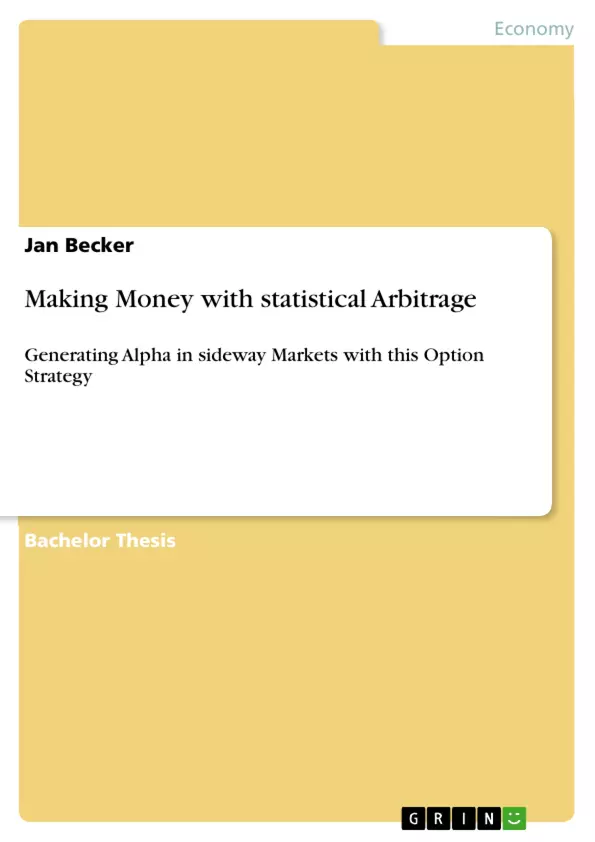In the following bachelor’s thesis I am going to present a short survey of the hedge fund industry, its regulation and the existent hedge fund strategies. Especially statistical arbitrage is explained in further detail and major performance measurement ratios are presented. In the second part, I am going to introduce a semi-variance model for statistical arbitrage. The model is compared to the standard Garch model, which is so often used in daily option trading, derivate pricing and risk management. Because investment returns are not equally distributed over time, sources for statistical arbitrage occur. The semi-variance model takes skewness into account and provides higher returns at lower volatility than the Garch model. The concept is aimed to be a synopsis of mean reversion and chart pattern detection. The computer model is generated with respect to Brownian motion and technical analysis and provide significant returns to the investment. As market efficiency hypothesis states the impossibility of arbitrage opportunities over the long run, on the other hand market anomalies significantly outstand. Connecting both elements creates a profitable trading system. The combination of both approaches delivers a sensible hedge fund concept. The out-ofsample backtest verifies out-performance and implies the need for further research in the area of higher moment CAPM and additional market timing strategies as sources of statistical arbitrage.
Inhaltsverzeichnis (Table of Contents)
- Part I
- 1.1 Abstract
- 1.2 Structure
- 1.3 Table of Contents
- 1.4 List of Abbreviations
- 1.5 List of Figures and Tables
- Part II
- 2.1 Overview of the Hedge Fund Industry
- Part III
- 3.1 Hedge Fund Strategies Overview
- 3.2 Statistical Arbitrage in Detail
- 3.3 Performance Analysis
- Part IV
- 4.1 State of the Art in Research
- 4.2 Principles of Garch
- 4.3 Introduction of a Semi-Variance Model
- 4.3.1 Methodology
- 4.3.2 Description of Market Data
- 4.3.3 Prediction Power
- 4.3.4 Risk Measurement
- 4.4 Backtest with Real Options
- 4.4.1 Out-of-Sample Market Data
- 4.4.2 Performance Comparison
- Part V
- 5.1 Conclusion
- 5.2 Further Research
- Part VI
- 6.1 List of Literature
- 6.2 Appendix
Zielsetzung und Themenschwerpunkte (Objectives and Key Themes)
This bachelor's thesis aims to present a comprehensive overview of the hedge fund industry, focusing on statistical arbitrage. The thesis explores the development of a semi-variance model for statistical arbitrage and compares its performance to the standard Garch model. The study investigates the potential for arbitrage opportunities in the context of market efficiency hypothesis and market anomalies. Key themes include:- Statistical Arbitrage
- Semi-Variance Model
- Garch Model
- Market Efficiency Hypothesis
- Market Anomalies
Zusammenfassung der Kapitel (Chapter Summaries)
- Chapter 2.1 provides a general overview of the hedge fund industry and its regulation.
- Chapter 3.1 presents a comprehensive overview of various hedge fund strategies.
- Chapter 3.2 delves into the concept of statistical arbitrage in greater detail.
- Chapter 3.3 focuses on performance analysis and key performance measurement ratios.
- Chapter 4.1 examines the existing research on statistical arbitrage and related concepts.
- Chapter 4.2 explains the principles of the Garch model, a commonly used model in option trading, derivative pricing, and risk management.
- Chapter 4.3 introduces the semi-variance model, outlining its methodology, description of market data, prediction power, and risk measurement considerations.
- Chapter 4.4 presents a backtest of the semi-variance model on real options, examining both out-of-sample market data and performance comparison.
Schlüsselwörter (Keywords)
This bachelor's thesis focuses on the application of statistical arbitrage strategies within the hedge fund industry. The main keywords include statistical arbitrage, semi-variance model, Garch model, market efficiency hypothesis, market anomalies, risk management, and performance measurement ratios. The thesis aims to contribute to the understanding of arbitrage opportunities and the potential for exploiting market inefficiencies.- Quote paper
- Jan Becker (Author), 2010, Making Money with statistical Arbitrage, Munich, GRIN Verlag, https://www.grin.com/document/194770



